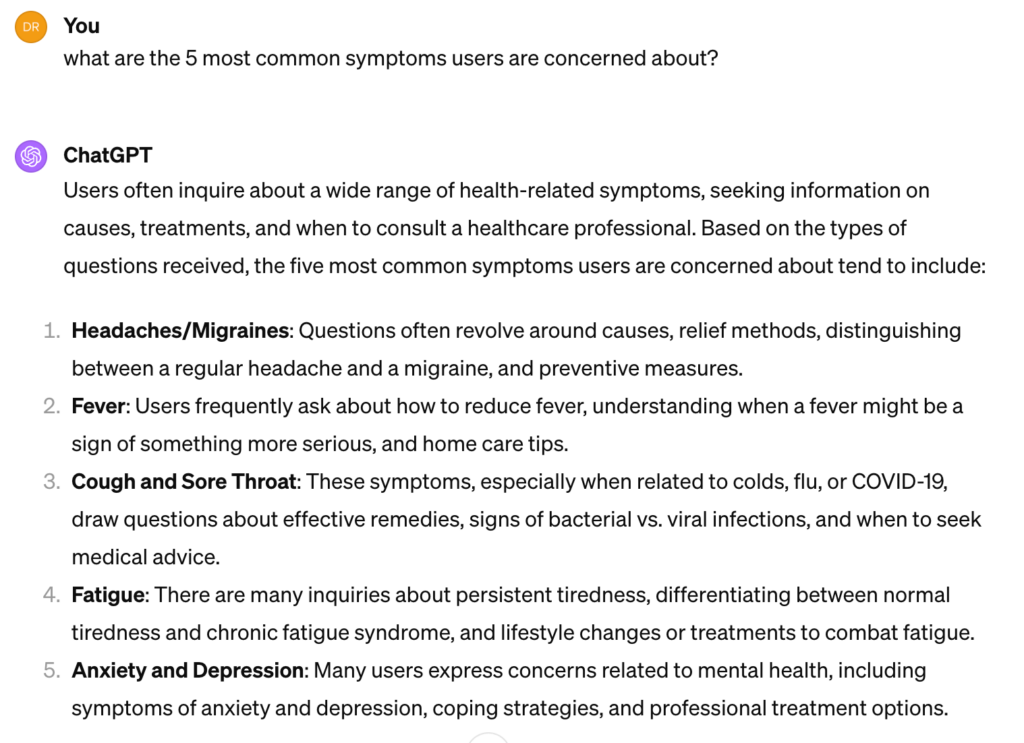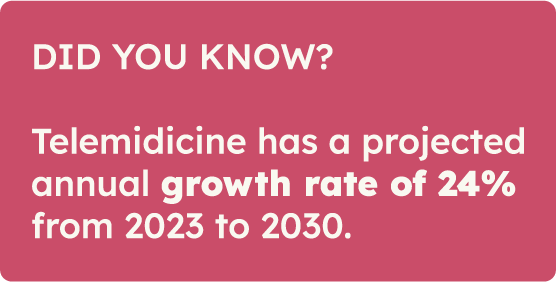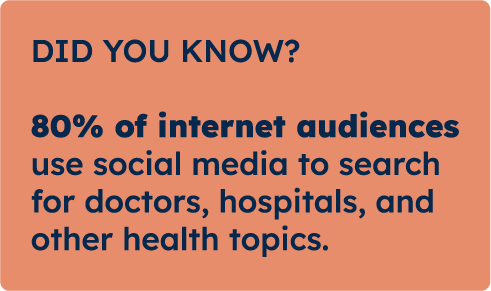Though we’re just a few months into 2024, it’s clear that healthcare marketing will continue to be influenced by the latest technologies and increasing patient demands. The experience from previous years has shown that healthcare providers can no longer rely on traditional and generic types of promotion. Instead, precisely developed marketing plans powered by digital services are a necessity for everyone who wants to put their medical care into the spotlight.
To stand out in today’s market full of different offers and tactics, you must follow and adapt to healthcare marketing trends if you want long-term success. Getting familiar with them at the beginning of the year keeps you prepared for the upcoming challenges, with the possibility to act on time. We put together a list of our top picks among the trends that will help you get more from your healthcare marketing in 2024.
The Rising Power of AI
 Artificial Intelligence (AI) has been around for a while, but it erupted in the previous couple of years. Generative AI services like ChatGPT have drastically changed the nature of online searches—many of today’s patients describe their symptoms to the AI chat hoping to get answers before seeing the doctor.
Artificial Intelligence (AI) has been around for a while, but it erupted in the previous couple of years. Generative AI services like ChatGPT have drastically changed the nature of online searches—many of today’s patients describe their symptoms to the AI chat hoping to get answers before seeing the doctor.
The reason behind including AI in healthcare marketing trends in 2024 is simple—it makes things easier and faster. AI-powered platforms can help you create personalized marketing campaigns and deliver content that can attract new patients and retain existing ones. For example: we asked ChatGPT what are the most common healthcare-related questions it gets from users – here’s what it said:

Now, you can use this feedback to create topic categories you’ll cover throughout the year within your content strategy. However, we do suggest getting more specific with questions before you put your strategy together. We followed up on this by asking about the most common symptoms people experience: 
These are all useful insights that can direct your marketing efforts and make your brand relevant online. You can continue this research by asking AI to suggest topic ideas that address these concerns, how to convey these messages in different media formats (blog posts, short videos, infographics, newsletters, etc.), and even have it write the content for you – the possibilities seem endless. However, when you do this research, make sure to include other, still very relevant, aspects, such as keyword research, Google trends, and social media trends.
When it comes to tracking your efforts, turning to AI-driven analytics helps you target specific audiences, enhance patient engagement, and enable more personalized care. The effect of this approach reflects on greater awareness of your practice, positive feedback, and recommendations.
Finally, AI can help healthcare providers interact with their patients. For example, website chatbots simulate a conversation with your patients in real time. Using Natural Language Processing (NLP) to understand and respond in human language, they answer the patient’s questions quickly and determine the next steps in their treatment. Finally, they guide patients directly to you, armed with information about their condition.
That’s only a small glimpse into the possibilities of AI. However, don’t follow this trend blindly. Many aspects of your practice, such as reputation and compliance with Health Insurance Portability and Accountability Act (HIPAA) rules depend on the content you publish, so make sure that everything that goes from your kitchen is healthy. In other words, make sure to both provide valuable information and rigorously protect patient privacy.
Telemedicine – The Gateway for Remote Help
 While in-person interaction with a doctor is usually irreplaceable, the COVID-19 pandemic in 2020 led to a shift. Since then, the use of technology for remote healthcare, known as telemedicine, has been a common way of treating patients.
While in-person interaction with a doctor is usually irreplaceable, the COVID-19 pandemic in 2020 led to a shift. Since then, the use of technology for remote healthcare, known as telemedicine, has been a common way of treating patients.
With the projection of an annual growth rate of 24% from 2023 to 2030, telemedicine well deserves its place as one of the healthcare marketing trends in 2024. This shows that a growing number of patients will choose calling or messaging over visiting a doctor. That makes telemedicine one of the most effective channels for promoting your practice, allowing you to build confidence and strengthen engagement while providing care.
There are several telemedicine marketing strategies to attract patients and all of them rely on trust, an element necessary for every part of the healthcare business. Since the lack of in-person contact can impact sensitive decisions like choosing a doctor, the effort to earn your patients’ confidence should be the crucial step in using telemedicine as a marketing tool. To achieve that and stay at the disposal of your distant or busy patients, you must employ a strategic approach. Failing to create a detailed plan with clear goals means missing out on a significant opportunity to grow your healthcare organization and remain relevant in the eyes of modern patients.
Local SEO – Stay on the Map
When you need a specific service, you likely grab your phone, do a Google search, and find the nearest option that seems trustworthy. That’s exactly what people do when searching for healthcare.
Local Search Engine Optimization (local SEO) is one of the healthcare marketing trends that will prove its importance again this year. With patients who seek clarity, precision, and easy access to desired treatment more than ever, local SEO is a key link between you and them.
Social media profiles or websites are worth little without an optimized path that leads patients directly to your door. Using local SEO levels up your practice to top choices in the community, potentially associating your name with the specific care you provide.
Listings are key details about your practice. They include NAP (name, address, and phone number), office hours, and services, and help you to be easily found by potential patients. To keep them accurate, you should rely on listing management and use strategic tools that allow you to control and update your business information across online directories, such as social media and search engines.
The key step for improving local SEO through listing management is setting up and optimizing healthcare directories like Healthgrades, Vitals, etc. as well as Google Business Profile (GBP) and Apple Business Connect (ABC). By managing these free business pages, you cover a wide area of interest, regardless of your patients’ different preferences.
Keep the Website User Experience a Priority
 Keeping your website optimized and updated never gets old. If you ask why you should stick to that in 2024, look for the answers among your patients and Google. They both want the same—easy access to the information, smooth navigation, relevance, and unique content. Fulfilling these preferences keeps the patients satisfied, your website remains favorable in Google’s eyes, and you stay in line with healthcare marketing trends.
Keeping your website optimized and updated never gets old. If you ask why you should stick to that in 2024, look for the answers among your patients and Google. They both want the same—easy access to the information, smooth navigation, relevance, and unique content. Fulfilling these preferences keeps the patients satisfied, your website remains favorable in Google’s eyes, and you stay in line with healthcare marketing trends.
And don’t forget the design. Adopt the latest web design standards to make your website more compelling and user-friendly to your patients. However, while having a chic and reliable healthcare website is great, what’s the purpose if only a few are aware of it?
Website search engine optimization (SEO) in simple terms means making your website more visible to search engines, like Google or Microsoft Bing. This helps your patients find you easily and make faster interactions. Effective SEO combines important keywords, high-quality content, a suitable website structure, and trustworthy links to improve your website’s rankings in search results.
But you need to know that SEO is not a one-time wonder. It needs time and a set of strategic steps, such as setting clear goals, realistic expectations, and consistently optimizing efforts over time. Healthcare SEO is a long-time investment, but it’s well worth waiting for the results it brings.
Social Media Is Still in the Game
Not including social media in healthcare marketing trends in 2024 would be a huge mistake. With the staggering prediction that the number of social media users in the US will cross 313 million this year, it’s obvious that the power of social media for healthcare organizations will only keep skyrocketing.
Social media remains a valuable ally to healthcare providers. With 80% of the internet audience using them to search for doctors, hospitals, and other health topics, you have to be present on various platforms to understand and meet the patients’ demands.
Changes are common on social media, constantly influenced by new technologies, market interests, and user demands. Staying updated with them is highly important for a strong online presence and effective doctor-patient engagement.
Like all users, your patients have a wide range of choices and are becoming more selective, which affects the dynamics of using healthcare marketing trends. To maintain an optimal dynamic on social media, share original content that mirrors your mission, experience, and care. Your healthcare practice has a unique approach, so make sure to present it through different social media platforms. Put yourself in your patients’ shoes to understand their questions and concerns. This allows you to create unique content based on your expertise and patient needs.
Blend Multiple Channels To Benefit from Different Healthcare Marketing Trends in 2024
Potential patients are everywhere on the internet, using various platforms to find medical care. That means single-channel marketing communication can’t be considered one of the efficient healthcare marketing trends in 2024. You should explore different routes for promotion, considering the different touchpoints your patients come across on their way to your doorstep.
With the help of multichannel and omnichannel marketing strategies, patients can comfortably interact with you using their preferred device, while they can collect, analyze, and optimize information to enhance care. However, with HIPAA compliance pervading all healthcare marketing efforts and the demanding nature of such strategies, using automated and integrated solutions may be an even better choice.
SocialClimb’s comprehensive marketing platform allows you to effectively manage all of your promotional strategic steps and utilize the latest marketing trends while staying compliant with HIPAA. With our help, you leverage automated solutions by managing all your content, feedback, and performance analytics through a single marketing platform. That puts you in control of your whole online presence, saves time and money, and positions you at the forefront of healthcare marketing trends in 2024.











